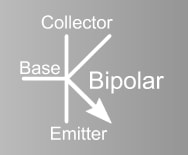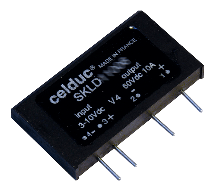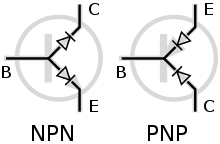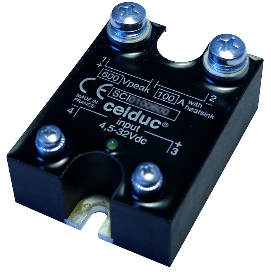Choosing a DC Solid State Relay transistor technology
Follow articleHow do you feel about this article? Help us to provide better content for you.
Thank you! Your feedback has been received.
There was a problem submitting your feedback, please try again later.
What do you think of this article?
What are the different DC Solid-State Relay transistor technologies and how to choose the correct one?
DC (Direct Current) Solid-State Relays allow to switch DC loads (solenoid valves, brakes, LEDs, motors, …).
DC solid-state relays can be composed of different types of transistors (MOSFET, IGBT, Bipolar). However, it can be difficult to choose the correct technology depending on the application.
This article will introduce the different technologies available on the market, and how to choose the correct one.
AC Solid state relays vs. DC solid state relays
AC (Alternative Current) solid-state relays
AC solid-state relays are composed of thyristors or triacs.
A thyristor, also called SCR (Silicon Controlled Rectifiers) is an electronic semiconductor switch composed of two main terminals called Anode and Cathode, and a control terminal called the Gate. A thyristor conducts current in one direction only.
A triac (Triode for Alternating Current), is an electronic semiconductor, equivalent to two back-to-back thyristors. It is composed of three electrodes (anode 1, anode 2, gate) and conducts current bilaterally.
DC (Direct Current) solid-state relays
DC solid-state relays are equipped with transistors.
A transistor is used to rectify, modulate, or amplify electric currents. It can be a Bipolar, IGBT (Insulated Gate Bipolar Transistor) or MOSFET (Metal Oxide Semiconductor Field Effect Transistor) type.
Choose between the technologies
Introducing the technologies
DC Solid-State Relay with MOSFET transistor
MOSFET (Metal Oxide Semiconductor Field Effect Transistor) transistors are composed of three terminals: the drain, the gate and the source. A MOSFET transistor generates voltage through the gate. It is a unipolar component.
DC MOSFET Solid-State Relays are used for applications requiring transient overcurrent withstand (motors).
The advantage of MOSFET technology is that it generates a very low voltage drop when the load voltage is low. Nevertheless, the control current is high. The voltage drop can be high when the load voltage is also high.
DC MOSFET Solid-State Relays from celduc® relais :
DC Solid-State Relay with Bipolar transistor
Bipolar transistors are composed of 3 terminals (Base (B), Collector (C), Emitter (E)), and of three semiconductor layers: NPN or PNP. Each one has different directions. A Bipolar transistor is controlled through current.

DC Bipolar solid-state relays fit applications with low control current and are recommended for resistive and inductive loads. They work the same way as a current amplifier.
The advantage is that a DC Bipolar solid-state relay can be controlled by a very low current. Nevertheless, the voltage drop is high when the load voltage is low, even if the load current is also low.
DC Bipolar Solid-State Relays from celduc® relais :
DC Solid-State Relay with IGBT transistor
DC IGBT (Insulated Gate Bipolar Transistor) solid-state relays are used for power electronics (>600VDC). An IGBT transistor generates voltage through the gate. It is a hybrid transistor, regrouping a MOSFET transistor on the input and a Bipolar transistor on the output. It is composed of three terminals: the collector, the gate, and the emitter.
The advantage of a DC IGBT solid-state relay is that it combines the advantages of both Bipolar and MOSFET transistors. Nevertheless, the control current is relatively high.
DC IGBT Solid-State Relays from celduc® relais :
Choose the correct technology
This graph allows you to easily define the necessary technology depending on the nominal current and nominal voltage of the application.
Applications examples for DC Solid-State Relays
- DC power supplies converters like choppers or inverters
- Signal switching like testing or monitoring equipment
- Electro-magnets like induction motor braking systems
- Heating elements like air conditioning in trains or tramways and de-icing of railways
- Batteries like boat batteries or solar energy storage systems
- DC Motors like travelling cranes, cranes, or construction machines
celduc® relais is a solid-state relay expert, manufacturing all of its products in France. The SSR manufacturing at celduc® guarantees quality and reliability for each product.




















